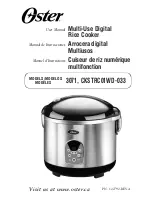
13
INTERNAL/FLUE CLEANING
The flue or chimney will need to be cleaned
regularly. How often will depend a lot on how your
Cooker is run, but, to start with, make a point of
inspecting the flue system every one or two weeks.
This period may well be extended as time goes by if
there is little sign of deposits. Some people find
they need to sweep the flue every six to eight weeks
but a longer period is more normal and in some
cases this may be as long as 12 months.
For most efficient heat transfer to water jacket, all
surfaces that come into contact with the flue gases
should be kept clean. Regular cleaning will
maintain the efficiency of the unit. Use the scraping
tool to remove deposits from the inside surfaces of
the firebox, the flue ways and top water tube.
Regularly look at the top and side of the oven by
removing the hotplate cleaning panel and removing
the deposits with scraper. To help keep deposits to
a minimum, it is a good idea to have a fast fire for 15
minutes at least once a week. Loose deposits will
be scoured off and will make the necessity of
cleaning out less frequent.
Fig.17
Fig.18
The insulating covers retain most of the heat that
would otherwise be radiated into the kitchen. They
also retain the heat in the hotplates so that rapid
heating of cooking utensils will result when one or
both of them are lifted for cooking purposes. (See
Fig. 16)
COOKING UTENSILS
For best cooking results use heavy based, flat
bottomed utensils.
USE OF OVENS
When baking or roasting, close the direct damper
and open the thermostat fully until the thermometer
shows a temperature about 50
o
F higher than that
which is required. Then close the thermostat to a
point where the required temperature is sustained
(a little practice will soon show how much thermostat
adjustment is necessary). Much will depend on the
strength of the chimney draught. It will be found that
a thermostat setting of 3 will be suitable in most
cases.
The main oven is heated on all four faces. The
simmering oven is heated on the top face only.
The temperature will be about half that of the main
oven, for slow cooking, of casseroles, stews, soups
etc.
HOTPLATE INSULATING COVERS
Fig.16
2.
Insert the support legs (item 1) through the
fire door and rest them on the shaker grate
support lugs. To lock support legs into
position, fit legs as per fig. 15.
3.
Insert the summer grate (item 2) through the
fire door and rest it on the support legs
(item 1).
4.
Insert the heat shield plates in the following
order - items 3, 4 and 5.
NB.
When using the summer grate and heat
shields it will be necessary to use a poker to
clear ash before refuelling.
Every week, depending on the type of fuel used, it
will be necessary to take off the cleaning access
plates to remove deposits. Some people use a
vacuum cleaner to remove these deposits. The
procedure is as follows: Allow cooker to cool down




































